STRIKEWATCH 1971. King's Birthday Holiday was a contract issue... 1971 CTU strike braved January's bitter cold, won raises and other benefits for CTU and better schools for all
The 1971 Chicago Teachers Union strike lasted four days in the January snow and brought a two year contract with raises and other improvements. The teachers walked the picket lines with signs that read "On Strike for our Contract" and "On Strike for Better Schools" as well as home made signs (some specially designed to greet scabs who crossed the lines at several schools). The two-year contract brought raises and increasing power to the union. But it was a lot of work for everyone involved.
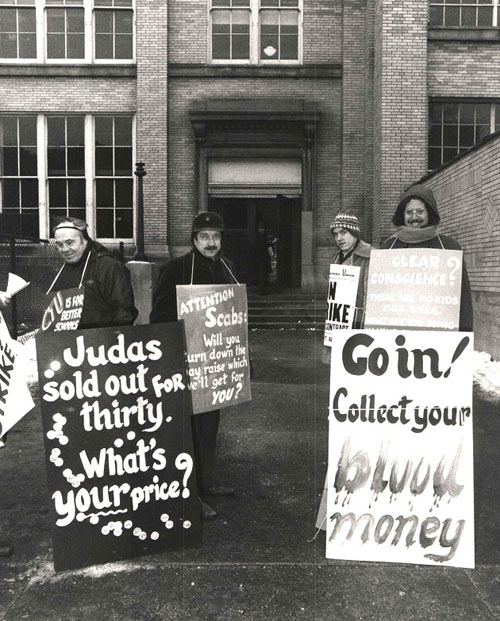 The Board of Education couldn't open even one school for students during the strike, but they did begin a tradition of allowing any scab to cross the line, sit without kids inside a warm building, and earn full pay. The pickets greeted the scabs with firm warnings, and at some schools pickets also instituted what was called "the principal of reciprocal sacrifice." The Chicago Teachers Union's second strike lasted for four days — January 12 through 15, 1971 -— and resulted in an eight percent salary increase for teachers, a seven percent increase for career service staff, and the restoration of thousands of jobs the Board had claimed it had to cut. The Union also succeeded in forcing the Board of Education to open 600 new teaching positions.
The Board of Education couldn't open even one school for students during the strike, but they did begin a tradition of allowing any scab to cross the line, sit without kids inside a warm building, and earn full pay. The pickets greeted the scabs with firm warnings, and at some schools pickets also instituted what was called "the principal of reciprocal sacrifice." The Chicago Teachers Union's second strike lasted for four days — January 12 through 15, 1971 -— and resulted in an eight percent salary increase for teachers, a seven percent increase for career service staff, and the restoration of thousands of jobs the Board had claimed it had to cut. The Union also succeeded in forcing the Board of Education to open 600 new teaching positions.
The strike was successful in that Union leadership was learning how to use the media to bring to the public the concerns of its members and the state of public education in Chicago. The voices of thousands of teachers (along with parent supporters and students) were hard to ignore, even for the often biased press (like the Chicago Tribune).
Perhaps the biggest gain for CTU members, however, was the Board of Education's acquiescence to the Union's demand for 100 percent payment of premium costs for individual and family hospitalization and medical insurance. This gain was to last for more than a generation. It wasn't until the 1990s — and the attacks on the union from Springfield with the passage of the Amendatory Act of 1995 and the onset of corporate school reform in the form of mayoral control — that the Board of Education was able to begin eroding the medical and dental insurance benefits for Chicago Teachers Union members.
The two-year agreement was ratified on a vote of 7,126 in favor and 1,243 against. Its expiration in 1973 was to bring about another strike, as the Board continued its attacks on the teachers. (More about that in a future chapter of Substance Strikewatch).
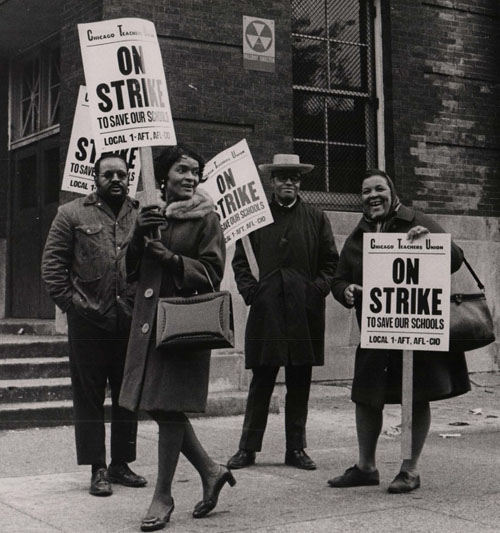 The Board of Education did not believe that the union was capable of picketing at more than 500 schools at the same time. Nor did the Board in 1971 believe that the union could get a strike vote of more than 90 percent. Both fantasies were proved false by the first day of the strike (above). Frpm the beginning of its work for a written contract, the CTU had targeted class size and working conditions as well as pay and fringe benefits, as the historical record shows. The perennial issue of over-crowded classrooms also was addressed in the new 1971 contract. Two new programs were created that would work simultaneously to reduce class size.
The Board of Education did not believe that the union was capable of picketing at more than 500 schools at the same time. Nor did the Board in 1971 believe that the union could get a strike vote of more than 90 percent. Both fantasies were proved false by the first day of the strike (above). Frpm the beginning of its work for a written contract, the CTU had targeted class size and working conditions as well as pay and fringe benefits, as the historical record shows. The perennial issue of over-crowded classrooms also was addressed in the new 1971 contract. Two new programs were created that would work simultaneously to reduce class size.
Fifty schools were added to the listing of "maximum class size schools," according to the January 1971 edition of the CHICAGO UNION TEACHER, and an additional 100 schools would benefit from the Board hiring "between 500-600 additional teachers to relieve teachers with large classes." Class size maxima were also enforceable under Article 28 of the contract, and strong delegates would file grievances to achieve this enforcement for decades to come (until the grievane power was stripped away, again during the 1990s).
The union had always been organizing and negotiating over what were called "social justice issues" as well. Another major win of the 1971 contract was the Board's agreement to observe Dr. Martin Luther King's birthday as an official holiday beginning with the 1971-72 school year. Teachers still had vivid memories of the terrible days following the April 1968 assassination of Dr. King and the impact it had on Chicago. Union recording secretary Jacqueline Vaughn later told colleagues she remembered returning to Chicago after the King murder and seeing the sky lit up from the West Side fires of the 1968 riots from 50 miles away.
The UNION TEACHER said the strike action "was hailed as a victory for both teachers and students."
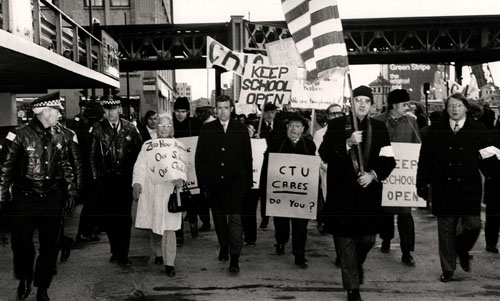 Part of the buildup for the 1971 strike came in the form of a CTU Cares march from the union's offices at 201 N. Wells St. to the Board of Education's headquarters (which were then at 228 N. LaSalle St.). The corner of LaSalle and Wacker, where the Board was located, was often the site of large union rallies. Above, CTU President John Desmond is carrying a hand-lettered "CTU Cares" sign, prior to the printing of the signs most teacher carried on the 500 or more picket lines during the subsequent strike.The Union took to a proactive role to prepare and mobilize the membership using its organizing strength, the media and Union representative bodies to prepare for a strike. Volunteers from the ranks of union members were active everywhere from the local school picket lines (and warming centers often hosted by supportive parents) to the union's downtown offices (which were then located at 201 N. Wells St., across the Chicago River from the current offices at the Merchandise Mart).
Part of the buildup for the 1971 strike came in the form of a CTU Cares march from the union's offices at 201 N. Wells St. to the Board of Education's headquarters (which were then at 228 N. LaSalle St.). The corner of LaSalle and Wacker, where the Board was located, was often the site of large union rallies. Above, CTU President John Desmond is carrying a hand-lettered "CTU Cares" sign, prior to the printing of the signs most teacher carried on the 500 or more picket lines during the subsequent strike.The Union took to a proactive role to prepare and mobilize the membership using its organizing strength, the media and Union representative bodies to prepare for a strike. Volunteers from the ranks of union members were active everywhere from the local school picket lines (and warming centers often hosted by supportive parents) to the union's downtown offices (which were then located at 201 N. Wells St., across the Chicago River from the current offices at the Merchandise Mart).
Picket signs not only read "On Strike for Our Contract," which was an abstraction to many, but "On Strike for Better Schools" — which the teachers could clearly explain to anyone who asked, citing issues from class size and school safety to desegregation. Clearly it has always been the practice of the Union to have a good faith effort to inform the Board and public of its intention and concerns with the working conditions in the public schools before any actions were taken. As usual, the Board claimed it was facing a "deficit."
Some of the planning had begun nearly a year before the January 1971 walkout. During a February 13, 1970 House of Delegates meeting, the union took the first steps to voice its displeasure with the treatment of its members. a resolution was adopted in solidarity with members that were slated to lose their positions, declaring, “We will not accept the removal of any of the stated programs or discharge of any personnel."
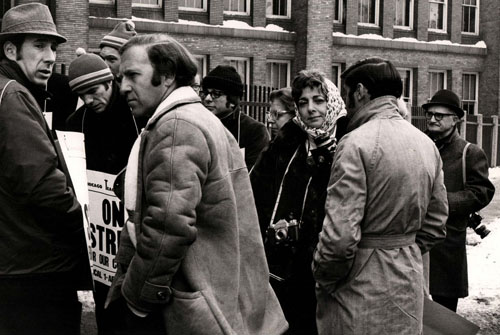 Because of the strength of their union leadership, some schools became more prominent in the future history of the union than others. The strength was forged for decades to come on the picket lines of the 1960s, 1970s, and 1980s.Later in the month, President Desmond warned that “Schools will be shut down” unless 4,500 jobs of elementary school physical education teachers and staff are restored. The threat came after 400 PE teachers where laid off by the Board of Education. Desmond went on to argue of the treatment of PE teachers as “low end of the totem pole,” who are the first commanded to do the worst jobs in the schools.
Because of the strength of their union leadership, some schools became more prominent in the future history of the union than others. The strength was forged for decades to come on the picket lines of the 1960s, 1970s, and 1980s.Later in the month, President Desmond warned that “Schools will be shut down” unless 4,500 jobs of elementary school physical education teachers and staff are restored. The threat came after 400 PE teachers where laid off by the Board of Education. Desmond went on to argue of the treatment of PE teachers as “low end of the totem pole,” who are the first commanded to do the worst jobs in the schools.
Although the media tried to find teachers and others who opposed the strike — and prominently feature them — the majority of teachers were taking advantage of the opportunity to talk about the issues when reporters bothered to visit them on the picket lines.
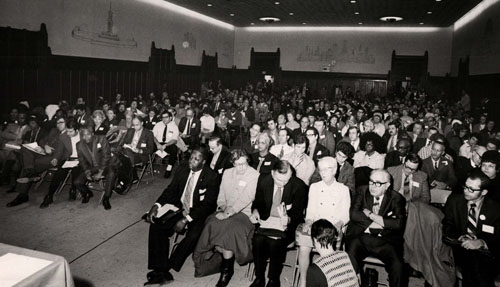 Mass meetings and meeting of school delegates were necessary to coordinate the strike. Above, at one of the delegates' meetings some of the union's officers sit in the front row, while President Desmond chairs the meeting from a stage (not visible in the photo). In the front row above are Glendis Hambrick, Alice Weatherwax, Robert Healey, Vivian Gallagher, and Joe Jacobs.In a March 4, 1970, Tribune interview Al Korach, 40 years old, a Laid off PE teacher from Rogers Elementary School, talks of the uncertainty with job loss, “Suddenly, I find I will have no job next year. I have no job security.” The attacks on the teachers during the early 1970s included mass layoffs, which made the teachers and other union members more committed to ensuring that the union contracts protected seniority of veteran teachers. Thanks to the 1971 strike, Korach was hired back and went on to a career in CPS. His wife, meanwhile, worked her entire career as a school clerk. The teachers who walked the line for the 1971 victory knew they were building not only for themselves (and their families) but for the future of the schools and their students. (Korach went on to become a union leader, and is still in 2012 a delegate representing retired teachers and a member of the Substance staff).
Mass meetings and meeting of school delegates were necessary to coordinate the strike. Above, at one of the delegates' meetings some of the union's officers sit in the front row, while President Desmond chairs the meeting from a stage (not visible in the photo). In the front row above are Glendis Hambrick, Alice Weatherwax, Robert Healey, Vivian Gallagher, and Joe Jacobs.In a March 4, 1970, Tribune interview Al Korach, 40 years old, a Laid off PE teacher from Rogers Elementary School, talks of the uncertainty with job loss, “Suddenly, I find I will have no job next year. I have no job security.” The attacks on the teachers during the early 1970s included mass layoffs, which made the teachers and other union members more committed to ensuring that the union contracts protected seniority of veteran teachers. Thanks to the 1971 strike, Korach was hired back and went on to a career in CPS. His wife, meanwhile, worked her entire career as a school clerk. The teachers who walked the line for the 1971 victory knew they were building not only for themselves (and their families) but for the future of the schools and their students. (Korach went on to become a union leader, and is still in 2012 a delegate representing retired teachers and a member of the Substance staff).
May 1970 brought about a direct mobilization and training of all Union members with the use of a training manual distributed by the American Federation of Teachers as a lesson plan for all teachers to use in their classrooms. The eight page supplement in eth May American teacher magazine was titled “Should Your Teacher Strike?” The supplement was subtitled “A Teaching Unit on Rights of Public Employees” prepared by labor historian Will Scoggins. The introduction to teachers was clear:
“This unit … ought to capitalize on the interest aroused by all thses recent events [referring to current militancy among public workers for greater benefits and wages] and promote class discussions on the rights of public workers.”
The goal of the first unit was to correct “misinformation, prejudice, and outright hostility concerning organizations of workers into union and their subsequent collective action to improve their lot.”
President Desmond pushed to make the material part of the official curriculum of the Chicago Public Schools by saying:
“More should be included in the curriculum on the teachers’ right to strike if he is unsatisfied with the working conditions and salary. We will definitely encourage our members to use this material in their civics lessons and other kinds of classes”
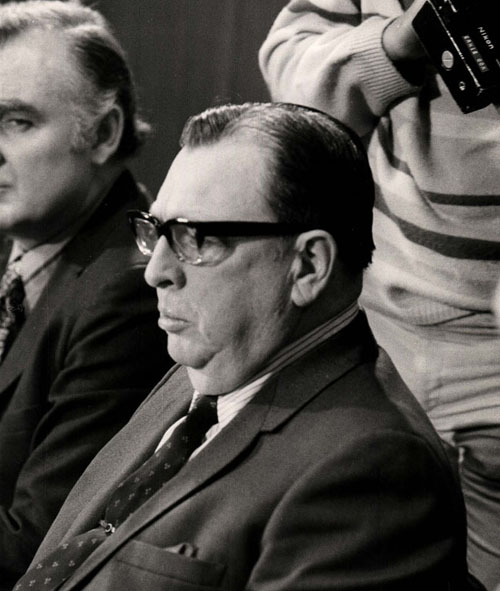 During media events and union meetings, John Desmond was usually accompanied by the other officers, one of whom was Robert Healey (left above) who succeeded Desmond as CTU President the following year. In a June 4 , 1970 statement CTU President Desmond warned that cutbacks by the Boiard of Education had and “unsettling effect” with the Union. He later went on to say that if “teachers needs were not met this fall [1970] members would definitely favor a strike.”
During media events and union meetings, John Desmond was usually accompanied by the other officers, one of whom was Robert Healey (left above) who succeeded Desmond as CTU President the following year. In a June 4 , 1970 statement CTU President Desmond warned that cutbacks by the Boiard of Education had and “unsettling effect” with the Union. He later went on to say that if “teachers needs were not met this fall [1970] members would definitely favor a strike.”
Again on July 24, 1970, John Desmond CTU President made clear that the Union’s first priority is the restoration of positions and programs which have been cut by the Board of Education and then to get a 10% raise for our teachers.
"Prior to the strike referendum, the Board of Education had not budged in its refusal to offer any kind of proposal for wage and school program improvements — or to guarantee that salary cutbacks would be restored with no strings attached," President John E. Desmond wrote in his regular column in the Union newspaper. "After eleven out of every twelve CTU members voted in favor of the strike, they did both."
President Desmond said the strike, with 93 percent participation by the Chicago Public Schools' employees represented by the CTU, was what convinced Board negotiators that they needed to respond to the Union's demands.
"Hopefully, our unity has one crucial point for all future negotiations: good faith bargaining cannot begin under threats of salary cutbacks," he said.
The Union leader called the class size provisions of the contract "a good start," but asserted that they "do not go far enough." He said approximately 1,200 new classrooms were needed to deal with the class size problem in an appropriate manner.
"When we succeed in establishing the present maximum class size policy throughout the system, we must fight to get that established class size limit lowered - 31 seven-year-olds cannot be taught well by one teacher." He said the class size issue would be a major component of the Union's proposals when CTU negotiators next met with Board representatives for a contract re-opener in January 1972.
President Desmond praised the Union's membership for its steadfast support through the period before and during the four-day walkout.
"I wish I could thank each of you personally for the long hours and the extra efforts you volunteered to keep your Union strong and effective," he said. "Each Union member performed an essential task during the strike. The cooperation and all-out effort of the Executive Board and the District Supervisors were essential to the success of the strike and the bargaining team's efforts in negotiations." Mr. Desmond cautioned, however, that the successful strike and new contract did not mean the war on behalf of workers had been won.
"Our united efforts won an important battle — this year — not only because of what we were able to get into the two-year agreement, but also because of what we were able to keep out — 122 school board demands that would have weakened the Union's effectiveness and strength.
"No one should be naive enough to think that we have yet come far enough to sit back and breathe a sigh of relief that the battle is over."
He added, "We shouldn't have to fight the public's battle for good schools — but we do."
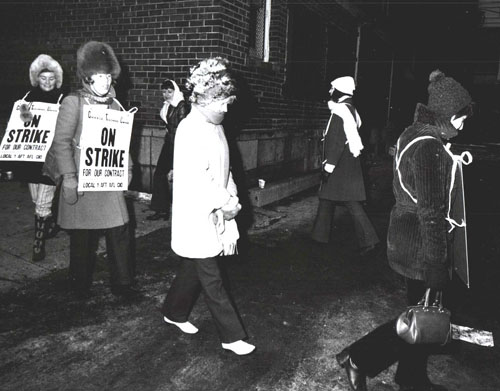 Most of the picket lines those cold January mornings had to begin before the sun came up, because many of the scabs tried to enter buildings before they were spotted by the pickets. Every day, pickets called in their numbers to the Union and called in the names of those who scabbed and those who witnessed the scabs crossing the lines.By the time the teachers walked out to walk picket lines at all of the city's schools, the Board of Education was offering to pay in full anyone who crossed the line and scabbed, but few did. "It was cold on that picket line that year," said George Schmidt, who had just begun teaching and was at the old Forrestville Upper Grade Center. We had a warming center, hosted by parents, at the project on Cottage Grove Ave. though, and there was never any doubt about the support we were receiving from parents and our students, despite all the drumbeats in the media against us."
Most of the picket lines those cold January mornings had to begin before the sun came up, because many of the scabs tried to enter buildings before they were spotted by the pickets. Every day, pickets called in their numbers to the Union and called in the names of those who scabbed and those who witnessed the scabs crossing the lines.By the time the teachers walked out to walk picket lines at all of the city's schools, the Board of Education was offering to pay in full anyone who crossed the line and scabbed, but few did. "It was cold on that picket line that year," said George Schmidt, who had just begun teaching and was at the old Forrestville Upper Grade Center. We had a warming center, hosted by parents, at the project on Cottage Grove Ave. though, and there was never any doubt about the support we were receiving from parents and our students, despite all the drumbeats in the media against us."
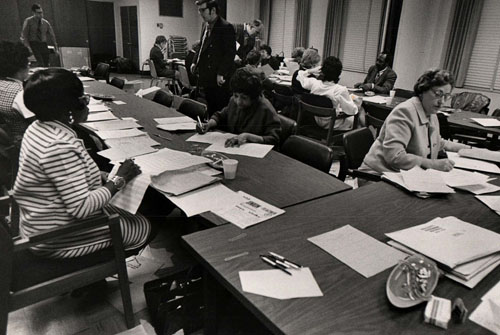 Union staff members and dozens of volunteers worked at times around the clock at the union's offices coordinating the strike. Every day, reports came in from school delegates and picket captains at every picket site, tallying the success of the strike and creating the list of identified scabs who would be put on trial later for betraying the union. At no time during the strike were there more than a handful of scabs crossing the picket lines at any school, despite the fact that picket duty was cold and a scab was promised a full day's pay for every day she or he crossed the line.Schmidt also noted that the veteran teachers at the time taught the new teachers like himself how the union worked. "One of the things our delegate taught was what he called 'The Principle of Reciprocal Sacrifice...'" Schmidt remembered. Every morning in the cold as we watched the handful of scabs cross the line and then taunt us from inside the building, we planned how to make sure they would share our sacrifices eventually."
Union staff members and dozens of volunteers worked at times around the clock at the union's offices coordinating the strike. Every day, reports came in from school delegates and picket captains at every picket site, tallying the success of the strike and creating the list of identified scabs who would be put on trial later for betraying the union. At no time during the strike were there more than a handful of scabs crossing the picket lines at any school, despite the fact that picket duty was cold and a scab was promised a full day's pay for every day she or he crossed the line.Schmidt also noted that the veteran teachers at the time taught the new teachers like himself how the union worked. "One of the things our delegate taught was what he called 'The Principle of Reciprocal Sacrifice...'" Schmidt remembered. Every morning in the cold as we watched the handful of scabs cross the line and then taunt us from inside the building, we planned how to make sure they would share our sacrifices eventually."
Although the Chicago Teachers Union was able to keep both the memory and spirit of Dr. King alive with the help of the victories in the 1971 strike, Chicago's massive segregation was still an issue. "The end of the first day of picketing at Forrestville," Schmidt recalled, "the delegate said to me, 'You've got to get more of your people out on the line tomorrow...' At first I didn't realize what he meant, and then he said 'Look around.' All of the pickets the first day of the strike were African Americans at our school. A few phone calls that night and we had a more balanced picket line the next day..."
NOTICE: Veteran teachers and others who have photographs and memories of the 1971 strike are asked to share them with Substance readers, either in "Comments" (above beneath the headline of the article) or by sending materials to Substance, 5132 W. Berteau, Chicago, IL 60641 or, if you have the material in digital form, to Csubstance@aol.com. We will be producing as comprehensive an illustrated history of all Chicago strikes as possible as the confrontation with the Rahmpage and the Mercencary Brizard Board escalates in the coming months.
References:
On Strike: A History of Job Actions by the Chicago Teachers Union
Schools Face Strike Over Phys Ed Cuts, Chicago Tribune, March 4, 1970; pg. 10
Teachers Seek 10% Cost-of-Living Hike, Sara Jane Goodyear, Chicago Tribune, July 24, 1970, p. 19.
Urge Class Talks on Teacher Strikes, Fred Morache, Chicago Tribune, June 4, 1970, p. N1.
Personal interviews with veterans of the 1971 strike.


By: Theresa D. Daniels
Grateful for these strike retrospectives
So far I've read about the two strikes that happened before I began teaching. Wonderful info in these articles. I look forward to reading about the strikes I do have strong memories of. My husband and I were interviewed for a Labor Beat film about the Chicago teacher strikes. I hope that our younger teachers who have never had the honor of striking are informed by all this and helped to appreciate the history of the union effort to upgrade and defend the schools and the profession of teaching.